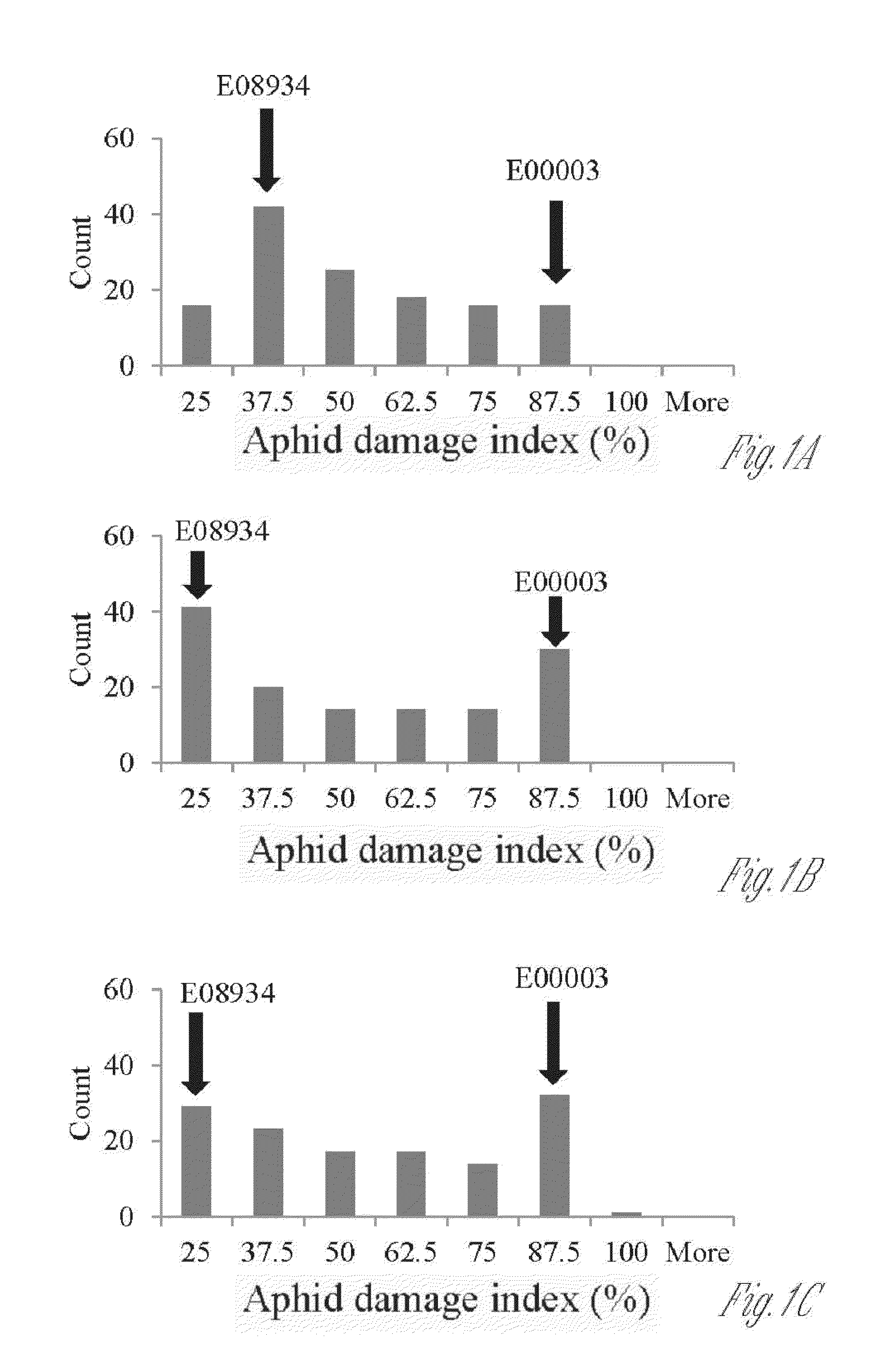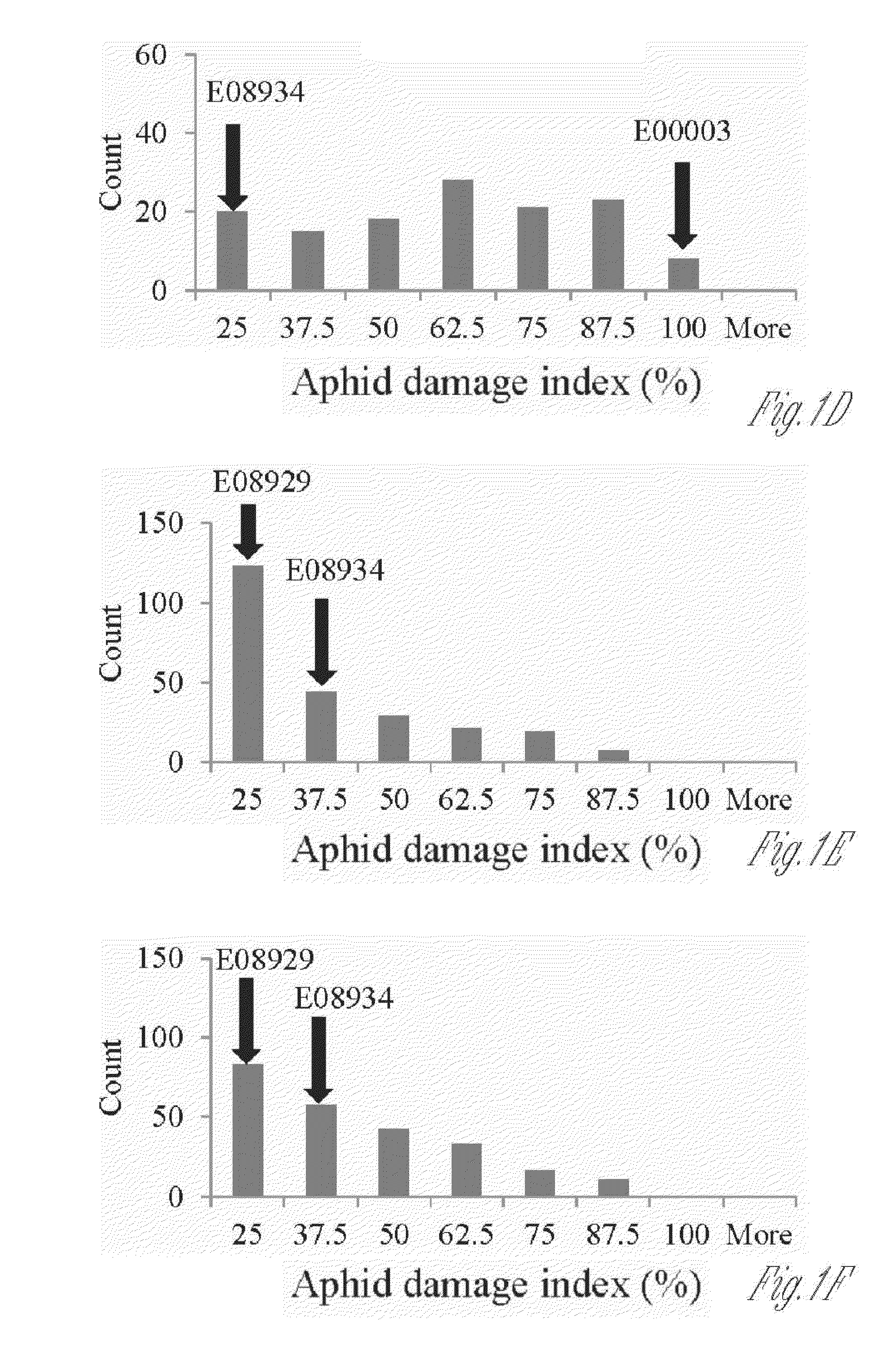New sources of aphid resistance in soybean plants
a soybean plant and aphid resistance technology, applied in the field of new sources of aphid resistance in soybean plants, can solve the problems of aphids being particularly difficult to control, wilting leaves, curling, yellowing and even dropping off, and achieving the effect of reducing aphid damag
- Summary
- Abstract
- Description
- Claims
- Application Information
AI Technical Summary
Benefits of technology
Problems solved by technology
Method used
Image
Examples
example i
[0442]This example describes the discovery of Rag6 and Rag3c in aphid resistant germplasm obtained from soybean line E08934.
[0443]Phenotype distribution of the mapping population. The aphid damage index (DI) of the two parents, from lines E08934 and E00003, together with the 140 F3-derived lines from the mapping population is summarized in Table 1. After four trials, resistant parent E08934, derived from G. soja accession had significantly lower DI than susceptible parent E00003 (P3-derived lines from the mapping population varied significantly (P<0.001) from 6.3 to 100.0 with standard errors of 19.6 to 27.4. The correlations between the three field trials are 0.71, 0.65 and 0.63 (P<0.05). The broad-sense heritability for DI of the field trials was estimated as 0.84 (P<0.001). The distribution of DI from the mapping population in the greenhouse trial and the three-year field trial is shown in FIGS. 1A-1D. The two field trials show similar patterns that are bimodal with a ratio of 1:...
example ii
[0474]This example describes MSU Soybean whole genome sequence data preparation and analysis as exemplary SNP site identification in Rag6 and Rag3c in aphid resistant germplasm obtained from soybean line E08934. In general, methods are described in Steemers, et al., Whole-genome genotyping with the single-base extension assay, Nature Methods, 3(1): 2006.
[0475]A. Plant Materials.
[0476]Table 5 shows sources of germplasm for use in producing (making) aphid resistant soybean plants of the present inventions. As one example, Line 19 was made from the cross E00003×E08934 which is new line E070020-19. E08934 was the male parent of E070020-19 and the female parent is E00003.
TABLE 5Parental lines for use in whole genomesequencing, and their breeding purposes.ACCESSIONPURPOSEPI 567597CAphid resistance (antixenosis)PI 567598BAphid resistance (two recessive genes: rag3, rag1b)(antibiosis)PI 567543CAphid resistance (Rag3) (antixenosis)PI 567541BAphid resistance (two recessive genes: rag4, rag1c)...
example iii
[0489]This example describes exemplary aphid resistant genes for use in stacking and / or pyramiding at least two or more aphid resistant germplasm regions in the same plant, i.e. having at least 3 aphid resistant genes in the same soybean plant for making soybean plants having enhanced aphid resistance.
[0490]Aphid resistant genes of the present inventions are contemplated to find use with other new aphid resistant genes. In some contemplated embodiments, aphid resistant genes of the present inventions are combined. In some contemplated embodiments, aphid resistant genes of the present inventions are combined with known aphid resistant genes.
TABLE 10Aphid resistance germplasm sources for use in the presentinventions. Bold denotes sources of aphid resistance germplasm and locidiscovered during the development of the present inventions.Resistancesource andType ofmaturity groupGeneInheritanceLocationresistanceMarkersReferenceDowlingRag1Dom. (oneChr. 7AntibiosisSatt463Hill et al.(PI 54866...
PUM
| Property | Measurement | Unit |
|---|---|---|
| aphid resistance | aaaaa | aaaaa |
| thickness | aaaaa | aaaaa |
| disease resistance | aaaaa | aaaaa |
Abstract
Description
Claims
Application Information
 Login to View More
Login to View More - R&D
- Intellectual Property
- Life Sciences
- Materials
- Tech Scout
- Unparalleled Data Quality
- Higher Quality Content
- 60% Fewer Hallucinations
Browse by: Latest US Patents, China's latest patents, Technical Efficacy Thesaurus, Application Domain, Technology Topic, Popular Technical Reports.
© 2025 PatSnap. All rights reserved.Legal|Privacy policy|Modern Slavery Act Transparency Statement|Sitemap|About US| Contact US: help@patsnap.com



